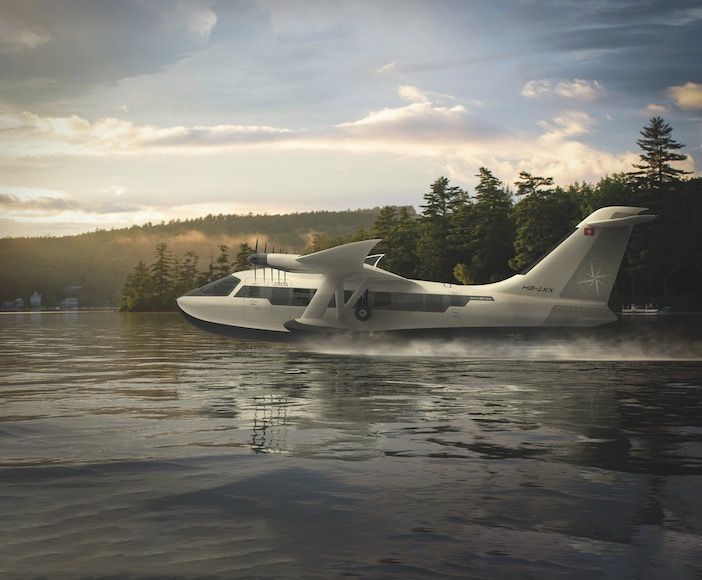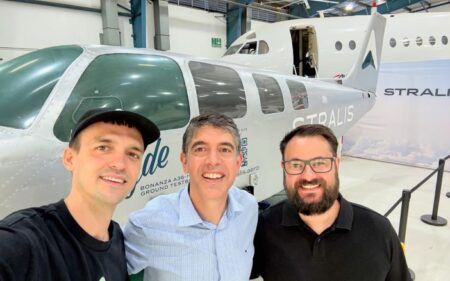Swiss startup Jekta is making steady progress with the development of its all-electric amphibious aircraft after announcing an agreement with key supplier Honeywell last month and has plans to flight test propulsion systems by the end of next year.
The PHA-ZE 100 (Passenger Hydro Aircraft Zero Emission) is the largest amphibious aircraft in development and when completed will be the world’s first electrically powered seaplane.
Jekta, which has founded in 2021 is building the 19-seat PHA-ZE 100 to be powered by either batteries or hydrogen fuel cells with an initial projected flight endurance of one hour and a 30-minute reserve.
The aircraft features a composite fuselage, without the floaters normally fitted to amphibious aircraft. The PHA-ZE 100’s design and low weight increase aerodynamic and fuel efficiency, which when combined with electrical propulsion enables operating costs for amphibious aircraft by 70%, according to Jekta.
Potential applications for the aircraft include eco-tourism and regional transport. The company plans for the PHA-ZE 100 to enter service in 2029.
Honeywell agreement
The agreement with Honeywell will explore which systems can be used in the PHA-ZE 100. The two companies will co-develop avionics, powertrain, flight control systems, and connectivity technology with the final system architecture and integration to be confirmed by the end of this year.
In addition, Honeywell and Jekta will work on the viability of enabling single-pilot operations when flying the PHA-ZE 100 aircraft.
The PHA-ZE 100 will be able to operate from coastal waters in waves up to 1.2m (4ft) high, lakes, waterways, and runways, the latter using its standard retractable wheeled landing gear.
George Alafinov, CEO of Jekta Switzerland said, “The signing of this agreement is a real vote of confidence for Jekta and the PHA-ZE 100, which will satisfy the travel demands of a whole new generation of passengers seeking affordable, environmentally friendly, regional travel solutions.
Jekta already has an order for 10 PHA-ZE 100s with Gayo, a Swedish-Dubai eco-tourism company that plans to use the aircraft for sustainable luxury travel and transport to remote areas.
Swiss production
Jekta is building a 26,901m2 production and flight test facility in Vaud, Switzerland which will include: design, certification, logistics, maintenance, and sales departments, an assembly hall, quality control lab, flight test organization and administrative offices.
The PHA-ZE 100 leans on decades of amphibious aircraft experience from Russian company Aerovolga, another firm founded and run by the Alafinov family. Aerovolga makes the eight-seat, all-composite LA-8 and the D-Borey ultralight seaplane.
Alafinov said, “We have used the technology and knowledge from those previous aircraft to design a Part 23 compliant, 19-seat aircraft suitable for commercial use. We have great experience with composite materials and an existing network of suppliers.
“It’s a completely new design, being put together by part of the same team using the same development and manufacturing processes.”
According to Alafinov the average journey of an amphibious aircraft is just 84km (50 miles), making the aircraft type an ideal candidate for electrification using current battery technology. Aircraft operations on seas and rivers are limited around the world because of concerns and rules regarding noise and pollution.
“A quieter, zero-emissions electric amphibious aircraft opens many new possible routes. In addition, the cost of maintenance and operation is less,” said Alafinov.
Route to certification
Jekta is working with the Federal Office of Civil Aviation (FOCA) in Switzerland and plans to certify the aircraft to EASA CS-23 and FAA FAR-23 standards.
Despite the unusualness of the aircraft, testing for use in water only adds about 16-20 hours to testing programs, said Alafinov. The most difficult technical challenge is ensuring that the hull is strong enough to repeatedly withstand the impact of landing on water.
“We’ve certified aircraft before and understand how complicated a process it is. We aren’t going to overpromise on development and certification timescales,” said Alafinov.
“The electric motors and battery have to be in hermetically sealed containers with liquid cooling. This is an advantage in terms of fireproofing and maintenance – the containers will be easy to swap,” Alafinov said.
The agreement with Honeywell means that the company has relationships with suppliers for all parts of the aircraft except the batteries and powertrain. The company’s engineers are to run a test program to gather performance data that will help specify a potential powertrain and which will include flight tests using a D-Borey aircraft by the end of next year.
Alafinov said, “The use of modern materials in the airframe means that we can decrease the weight of aircraft significantly without comprising its strength. I want to go back to the golden era of aviation when an airplane could go anywhere.”
There are around 360 seaplane operators around the world and more than 1,000 flying. The Swiss company is not the only one in the world developing electric seaplanes. Other firms developing and testing waterborne aircraft that use alternative powertrains include Canada-based Harbour Air and Australia’s Sydney Seaplanes.





